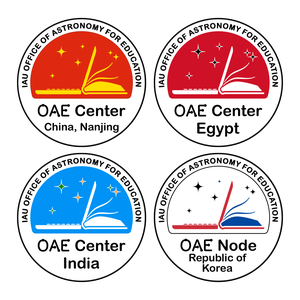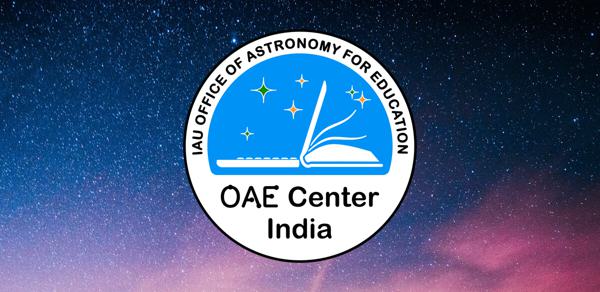Office of Astronomy for Education Adds Four New Branches to its Global Network
Published: 1st February 2022 12:00 (UTC)
The International Astronomical Union is pleased to announce the founding of four new “branch offices” of the Office of Astronomy for Education (OAE). The new branches are: the OAE Center China–Nanjing, hosted by the Beijing Planetarium (BJP); the OAE Center India, hosted by the Inter-University Centre for Astronomy and Astrophysics (IUCAA); the OAE Center Egypt, hosted by the National Research Institute of Astronomy and Geophysics (NRIAG); and the OAE Node Republic of Korea, hosted by the Korean Astronomical Society (KAS). The OAE itself was founded in December 2019, marking the IAU’s commitment to primary and secondary education, in particular in the areas of science, technology, engineering and mathematics (STEM). Astronomical topics are particularly effective in fostering students’ interest in STEM subjects.
The OAE head office was established by the IAU at the Haus der Astronomie and the Max Planck Institute for Astronomy in Heidelberg, Germany. Since then, the OAE has been building collaborations with partner organisations that share its mission — to promote and support the development and improvement of astronomy education, as well as the use of astronomy in science education more generally, all over the world. OAE Centers and smaller OAE Nodes are branch offices funded by host organisations that have an interest in supporting that mission. The new branches join three existing ones: the OAE Center Italy, OAE Center Cyprus, and OAE Node Nepal.
“The IAU and I are very happy to see the rapid growth of the network of OAE Centers and Nodes,” says IAU General Secretary José M. Rodriguez Espinosa. “This stems from the real need for the OAE as a fundamental pillar of the IAU to achieve its strategic goals. It also comes from the worldwide recognition of the relevance of the OAE’s activities, and willingness to be more closely involved with them.”
Markus Pössel, OAE Director, says: “We are very happy to be able to welcome our colleagues from China, India, Egypt and Korea to the team. This new development gives a considerable boost to our activities in support of astronomy education worldwide. The valuable contributions of the Beijing Planetarium, the Inter-University Centre for Astronomy and Astrophysics and Homi Bhabha Center for Science Education, the National Research Institute for Astronomy and Geophysics, and the Korean Astronomical Society will play an important role in helping us achieve our common goals.”
OAE Centers and Nodes make key contributions to the global projects developed by the OAE. In addition, they are active at national and regional levels by supporting initiatives in geographic regions, or in countries linked by a common language. Each Center or Node typically chooses certain areas of specialisation, corresponding to the host organisation’s experience and strengths.
The activities of the OAE Center China–Nanjing will include developing high-quality astronomical teaching resources, practical methods of teaching astronomy and professional training of astronomical teachers, seeking to cooperate with other countries in the OAE system.
“As a professional astronomical museum for science communication, Beijing Planetarium has been devoted to the popularisation and teaching of astronomical knowledge in China for more than 60 years,” says Rui Qi, from the Beijing Planetarium, who will coordinate the new Center. “Through years of practice, we have developed popular activities for science communication, and established close relations with many primary and secondary schools, making significant contributions to astronomy education in China. We are confident we will be an important OAE Center and help create a worldwide network of astronomers, educators and researchers on science communication.”.
The OAE Center India is managed by the Inter-University Centre for Astronomy and Astrophysics, Pune, in association with the Homi Bhabha Center for Science Education of the Tata Institute of Fundamental Research, Mumbai. It will focus on astronomy teaching methods and tools of assessment for middle- and high-school students and teachers, along with language inclusivity.
“Although the astronomy community has collectively created a large number of education resources in the last few years, there is a need for standardised tools and protocols to assess the quality and impact value of these resources, as well as those of the teacher training programmes that are currently conducted,” says Somak Raychaudhury, Director of IUCAA. “The OAE Center in India will strive to develop these tools and protocols, and also devise newer modules and training structures based on such an assessment. The activities of the Center will impact astronomy education in Indian schools and classrooms internationally.”
Somaya Saad, from the NRIAG, manages the OAE Center Egypt, whose focus is on Arabic-speaking countries. “The NRIAG is considered a beacon of astronomy education, awareness and outreach in Egypt and the Arab-speaking region,” says Somaya Saad. “It plays an essential role in this respect on an academic level through its different facilities of expert staff and resources. The hosting of the OAE Center Egypt will contribute much to supporting and strengthening this role. The NRIAG will cooperate locally and regionally with all stakeholders to realise the main goals of improving astronomy education from early stages to the secondary level of education, working closely with the OAE. In addition the NRIAG will support the contributions of astronomers, teachers and other education professionals to use astronomy as a catalyst for science, technology, engineering, and mathematics education.”
The OAE Node Republic of Korea, managed by Jungjoo Sohn from the Korean Astronomical Society, will focus on analysing the astronomy-STEM curriculum, training teachers, and developing educational resources. “We hope that the OAE Node Republic of Korea will play an important role in training school teachers to develop teaching competency in astronomy-related subjects,” says Jungjoo Sohn.
More information
The IAU is the international astronomical organisation that brings together more than 12 000 active professional astronomers from more than 100 countries worldwide. Its mission is to promote and safeguard astronomy in all its aspects, including research, communication, education and development, through international cooperation. The IAU also serves as the internationally recognised authority for assigning designations to celestial bodies and the surface features on them. Founded in 1919, the IAU is the world's largest professional body for astronomers.
The IAU Office of Astronomy for Education is hosted at Haus der Astronomie (HdA), managed by the Max Planck Institute for Astronomy. The OAE’s mission is to support and coordinate astronomy education by astronomy researchers and educators, aimed at primary or secondary schools worldwide. HdA’s hosting the OAE was made possible through the support of two German foundations: the Klaus Tschira Foundation and the Carl Zeiss Foundation.
The Beijing Planetarium (BJP) is the first large planetarium in Asia. There are four theatres, including two dome-screen theatres, dozens of astronomical theme exhibitions, multifunctional classrooms, advanced telescopes, and other facilities for education and science research. In addition to exhibitions, activities such as lectures, a portable planetarium, the Astronomy Photographer Competition, the Chinese National Astronomy Olympiad and astronomical summer and winter camps in BJP are also very much welcomed by students. Moreover, BJP has developed a series of astronomical courses in order to promote the extra-school education of astronomy, and conducted close collaborations with many universities, institutions and primary and secondary schools. Beijing Ancient Observatory, built in 1442, was the royal observatory during the Ming and Qing dynasties of China. It is now affiliated to the Beijing Planetarium.
The Inter-University Centre for Astronomy and Astrophysics (IUCAA), based in Pune, India, is a 30-year-old institution set up by the University Grants Commission (UGC), Department of Education, Government of India, to promote and coordinate teaching and research of astronomy and astrophysics at Indian universities. The Homi Bhabha Centre for Science Education is a National Centre of the Tata Institute of Fundamental Research with the goal of promoting equity and excellence in science and mathematics education in schools and undergraduate institutions.
The National Research Institute for Astronomy and Geophysics (NRIAG) is Egypt’s national astronomical, geophysical and environmental sciences research establishment. It has more than 110 years of successful history, making it the oldest research institute not only in North Africa but also in the Middle East and the Arab region. It is dedicated to exploring Earth and the Universe, besides addressing the needs of our researchers to be up to date with the precise technologies required to meet the modern scientific challenges in our fields of specialisation. NRIAG facilities spread all over Egypt, powered by more than 300 researchers covering different aspects of astronomy and geophysics.
The Korean Astronomical Society is the organisation of professional astronomers based in the Republic of Korea, established with the aim of fostering the advancement of astronomy research, application, and education.
Links
- https://www.astro4edu.org/
- http://www.bjp.org.cn/en/
- http://www.iucaa.in/
- https://www.nriag.sci.eg/
- http://en.kas.org/
Share on:
Contacts
Eduardo Monfardini PenteadoOAE Main Office
Coordinator
penteadoatastro4edu.org
Niall Deacon
OAE Main Office
Coordinator
deaconatastro4edu.org
Lars Lindberg Christensen
IAU Director of Communications
lars.christensenatnoirlab.edu









